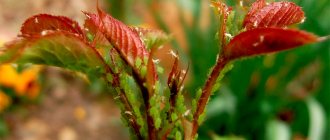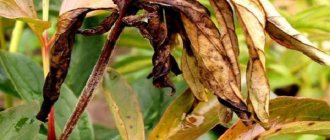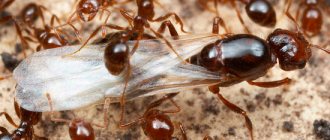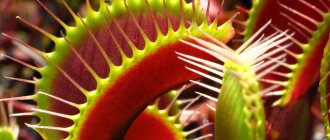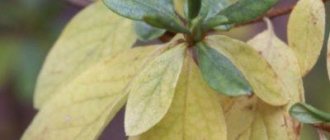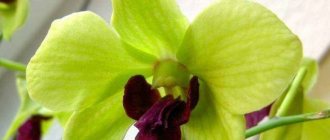Types of insects: name, description, causes and methods of treatment
Let's talk about the most common insects that can appear on a flower with their photos, descriptions and control methods.
Shield: how to treat?
Scale insects and false scale insects are yellowish-brown insects whose diameter does not exceed 5 mm. They mainly affect weakened orchid plants that are oversaturated with nitrogen fertilizers.
To combat these parasites, use a soap-garlic solution, ethyl alcohol and a soap-oil emulsion. The following insecticidal preparations are used: Fitoverm, Aktara, Aktellik.
White mealybug
Miniature insects with antennae and an oblong body, 3-6 mm in size, similar to snow-white lumps of cotton wool. They settle on flowers that are weakened and oversaturated with nitrogen fertilizers. To eliminate them, the plant is sprayed twice with Fitoverm.
Read more about mealybug control and signs of infestation here.
Poduras or multi-tails and the fight against them
Poduras, or polytails, are translucent white or light brown caterpillar-like insects. Pests appear as a result of excessive irrigation when moisture stagnates and silt deposits form.
You can get rid of polygons using the following means:
- washing the plant with soapy water;
- replacing 3-4 cm of the top soil layer with clean sand or ash for 4-5 months;
- spilling the substrate with Aktara, Fitoverm or Mospilan.
If there are a lot of dams, irrigation is reduced by half. If the roots rot, they are removed and the plant is replanted.
Thrips
Small insects no larger than 2.5 mm in size with paired wings that resemble sticks in appearance, multiplying rapidly in dry and warm environments. To get rid of them, the plant is isolated and then treated with Fitoverm or Actellik.
You will learn about what types of thrips attack an orchid and how to get rid of them from this article.
Nematodes
Nematodes are thread-like, half-transparent worms, 0.5-1 mm long. They integrate into the leaves, root system and buds of orchids and feed on their juice.
The causes of infection by nematodes may be the proximity of an infected plant, irrigation with poor-quality water, or transplantation into an affected substrate.
A hot shower, isolating the plant and treating it with antiparasitic drugs - Decaris or Levamisole - helps to destroy pests. In the fight against larvae and adult insects, treatment with insecticidal agents is effective: Fenamiphos, Carbofuran. In advanced cases, they resort to replanting the plant and calcining the prepared substrate in the oven.
Ticks
Small and very dangerous pests that are difficult to detect in a timely manner. There are bulbous, armored and spider mites. To combat them and to prevent the appearance of pests, heat treat the substrate in the oven for 5-10 minutes at a temperature of 150-180 degrees.
Read how else to deal with spider mites and oribatid mites here.
Aphid
A half-transparent flying insect 1-4 mm long. Aphids are found in greenish, black and whitish colors. The plant is attacked by insufficient irrigation and low humidity.
If the pest population is small, the bush is washed with clean warm water. When there are a lot of insects, the plant is treated with a soap solution or foamed laundry soap. Among chemical agents, a 3% solution of Chlorophos helps.
Whitefly or what to do if there are small insects in the soil?
A whitish insect with wings measuring 1-1.5 mm. Easily moves from one plant to another.
White bugs attack orchids due to high humidity, heat and poor air circulation.
Treatment of plants requires an integrated approach. The flower is washed with water and laundry soap. In such cases, processing of green mass with substrate, carried out using Aktara, Vertimek or Fitoverm, also helps. The second spraying is performed a week after the first.
Helps prevent re-invasion of whiteflies:
- increasing the humidity level in the room;
- systematic wiping of foliage;
- monthly watering of the soil under running water.
Snails, slugs and woodlice
Insects with an oblong shape and a scaly shell. They are dark gray and yellow marbled, with 7 pairs of legs. They often get into the soil in a plant pot when it is outdoors. You can actually lure them with a piece of cucumber or apple, then collect and dispose of them.
You can get rid of pests by washing the roots and replanting the plant in a fresh substrate.
Caterpillars
Any butterfly can visit an orchid standing outside and lay larvae on the foliage. If the clutch is not detected in a timely manner, the caterpillars will hatch. These are very voracious pests, capable of destroying the entire green mass in a short period of time.
It is possible to catch a few caterpillars by hand or spray the plant:
- onion or garlic infusion;
- wormwood decoction;
- peppermint tincture.
To combat numerous individuals, use “Dichlorobenzene” (acephate), acting according to the instructions.
Centipedes
These insects have an elongated body and many legs. Color varies from gray to rich brown. They move at high speed, making them difficult to catch.
Pests can be caught using bait made from potatoes, cucumbers and apples.
Some orchid owners place beer baits in flower pots. You can spill the substrate with warm water or spray it with Actofit or Bitoxibacillin. Transplanting the plant into a new substrate helps in the fight against them.
Root mealybug
Root insects are gray-yellow or light pink. They have an oval body and a length of 2-4 mm. They suck out the juice from the roots, which can lead to the death of the plant.
To fight the parasite:
- The flower is removed from the pot;
- The rhizome is washed and disinfected in a weak solution of manganese.
- The old substrate is disposed of and the pot is disinfected.
- The orchid is planted in new soil.
You can resort to treating the substrate with a dry contact-intestinal insecticide. Irrigation will lead to the dissolution of the powder and the death of insects.
Sciarids or midges
Miniature black midges that live in the soil. Their length is 3-4 mm.
The greatest threat to the orchid is the sciarid larvae; they eat the roots and cause enormous damage to the plant.
The appearance of fungus gnats is associated with systematic waterlogging of the soil. You can get rid of them by drying the substrate and irrigating with insecticides. The drugs are used according to the instructions. For flying species, aerosols must be used. The containers are treated until the pests are completely gone.
Aphid
Aphids on an orchid can also be seen with the naked eye: these are small green or black insects that most often settle on the underside of young leaves, sprouts and flowers of the plant. The presence of aphids can be determined by the following signs: the orchid leaves become deformed and become sticky. Like scale insects, aphids suck the juices out of the orchid and inject a toxic substance inside that destroys the plant cells. Insects are also dangerous because they are carriers of viral diseases and fungi.
Reason for appearance
Aphids actively reproduce on those orchids that lack air humidity or watering.
How to get rid of aphids
If you find pests when there are not too many of them yet, then thoroughly “bathing” the entire plant in the shower will help you deal with aphids. In this case, damaged flowers and buds from the orchid must be removed.
If there are a large number of insects, it is worth using a soap solution. It acts as an antiseptic, which is detrimental to many insects. You can treat the orchid either with laundry soap foam or with dishwashing liquid diluted in 1 liter of water (1 tbsp). After such treatment, it is recommended to spray the flower with Fitoverm or a solution of the drug Alatar.
Aphids on orchid leaves
Folk remedies
You can cope with aphids on an orchid using infusions. For example, onion infusion, which is prepared from an onion crushed into pulp, is poured with boiling water and infused for about 7 hours. The strained product should be sprayed on the orchid for 3-4 days several times a day.
Another effective infusion is prepared from citrus peels. Dried zest of lemons, oranges or tangerines (100 g) should be poured into 1 liter of water and left for 3 days. After this, the resulting infusion must be sprayed on the aphid-damaged orchid for several days every 4-5 hours. To consolidate the effect, dry citrus peels can be placed on the soil in a pot.
Prevention
In order to protect the orchid from aphids, the tropical plant must be kept in conditions favorable to it. In particular, it is extremely important to ensure sufficient humidity in the room - from 60% and above. Sufficient watering and timely fertilizing are also necessary.
Signs of flower infection
Several signs can indicate a pest infestation.
- The appearance of black spots on the foliage: they indicate a spider mite infestation.
- Silvery or moldy coating on leaves, peduncles, roots or buds.
- Redness and curling of leaf blades.
- Wilting of the plant.
- Root system rotting.
- The appearance of white, yellow, brown dry or wet spots on the leaves.
Spots on leaves sometimes occur from viral and bacterial diseases, as well as from violations of care conditions. Find details here.
How to get rid of it: step-by-step instructions
The method of getting rid of pests depends on the type of parasite and the degree of infection of the orchid. In some cases, folk remedies help, in others you have to use chemicals.
To save a plant from pests, you must:
- Isolate the orchid from other flowers.
- Carefully inspect the plant and remove any parasites found.
- Cut off damaged areas of greenery, sprinkle these areas with crushed coal, and treat with an antiseptic.
- Place the container with the flower in water for a few minutes. This will get rid of insects that float to the surface.
- Wipe the flower with a sponge dipped in soapy water. For varieties with dense foliage, you can use alcohol, the main thing is not to burn the green mass during this treatment.
- Replace the topsoil or the entire substrate. In some cases, a pot change is required.
Next, if necessary, treatment should be carried out with one of the chemical or biological agents.
Chemical and biological agents
You can rid your orchid of pests using the following medications:
- Aktara.
- Actellik.
- Fitoverm.
- Agravertine.
- BI-58.
Aktara: use and dosage in ampoules
It has an extensive intestinal-contact effect and helps well in the fight against various types of insects from scale insects to thrips and aphids. This is a safe product that provides the orchid with protection from pests for 2 weeks. Available in ampoules and powder. Ampoules are often used to treat indoor plants.
Dosage of dilution of the drug: a 1.2 gram ampoule is diluted in 6 liters of water and the plant is sprayed.
There should be weekly intervals between treatments. Aktar can be used in combination with Epin and Zircon.
Actellik: how to dilute?
A systemic insectoacaricidal agent that has proven itself in the fight against harmful insects that attack orchids. For long-term protection, a single treatment is usually sufficient. Actellik serves as a working solution. 1 ml of product is diluted in one liter of liquid.
The roots and stems, as well as foliage, are treated with the drug. If necessary, the procedure is repeated after 7 days. For maximum effectiveness, the treated plant is placed in polyethylene and kept for several days in a ventilated room.
Actellik is a drug of the second class of toxicity. When using it, it is important to follow safety precautions, use gloves, goggles, a respirator, and carry out processing outdoors.
Spray Bona forte
Suitable for getting rid of many crawling and flying insects.
It is best to carry out the treatment in the morning or evening in diffused light. Before use, it is better to test the spray on several leaves. If after 1-2 days everything is in order, then you can completely irrigate the flower. If necessary, the soil can also be treated with a spray.
Fitoverm
Biological insectoacaricidal drug that helps in the fight against mealybugs, aphids, mites, thrips. The remedy is used based on the type of parasite. To destroy spider mites, 1 ml of concentrate is diluted in 1 liter of liquid. For aphids – 1 ampoule in 600 ml of water. For thrips – 1 ampoule in 0.5 liters of water. In other cases, the dosage is 1 ml of product per 1 liter of liquid.
To destroy parasites, spraying with Fitoverm must be performed 4 times with an interval of 10 days.
Types of orchid pests and why they are dangerous
Insect pests can appear on orchids in various ways . They can enter the plant through an open window. A pet can bring fur from a walk.
There are many pests of orchids.
Even a thorough inspection in the store cannot protect against purchasing an orchid that is infested with pests. The easiest way to find insects is on the leaves and trunk of the plant, but there are pests that live in the substrate and on the roots.
They feed on parts of the plant , sucking out its juice and preventing it from developing. Gradually, the pests multiply and infest the entire plant, causing it to die. Another danger lies in viral diseases carried by certain types of insects.
Most common:
- Scale insects;
- Aphid;
- Fools;
- Spider mite;
- Nematodes;
- Mealybug;
- Thrips.
Prevention measures
The condition of the orchid must be monitored from the moment of its purchase. This will protect the flower from harmful insects.
- When purchasing, carefully inspect the plant.
- From time to time, inspect for spider webs with spots.
- Provide diffuse lighting for 12 hours a day.
- Regular spraying in the morning prevents waterlogging and drying out of the soil.
- Use settled water at room temperature for irrigation.
- Monitor the temperature: during the day the recommended value is 22-27 degrees, and at night – 15-20 degrees.
- Do not neglect the timely application of complex fertilizing.
- For replanting, use a soil mixture prepared by yourself, disinfect it by freezing or roasting in the oven.
What to do to prevent the plant from getting sick again?
- To prevent infection by parasites, newly acquired or returned flowers from the dacha are subject to a two-week quarantine. At this time, the plants should be kept in a room separate from the main flower garden under close attention.
- To prevent infection, it is necessary to select the correct watering regime so that the substrate has time to dry between operations, and carry out regular spraying, increasing air humidity.
- When replanting an orchid, it is better to use a high-quality substrate from a well-known manufacturer, and when using bark, it must be subjected to heat treatment.
To prevent bugs from appearing on orchids, it is necessary to systematically carry out a preventive inspection of them. Such an event will allow you to detect the problem in time, apply the most gentle methods of controlling parasites and prevent the entire flower garden from becoming infected.
